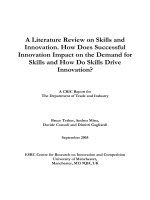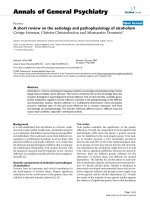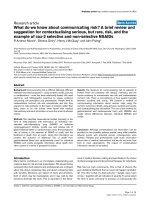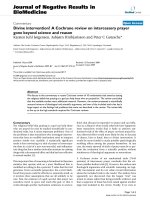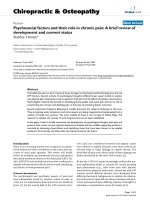A brief review on chrysanthemum aphid: Macrosiphoniella sanborni (Gillette) and its management
Bạn đang xem bản rút gọn của tài liệu. Xem và tải ngay bản đầy đủ của tài liệu tại đây (140.58 KB, 6 trang )
Int.J.Curr.Microbiol.App.Sci (2019) 8(4): 278-283
International Journal of Current Microbiology and Applied Sciences
ISSN: 2319-7706 Volume 8 Number 04 (2019)
Journal homepage:
Review Article
/>
A Brief Review on Chrysanthemum aphid:
Macrosiphoniella sanbornii (Gillette) and its Management
M. Saicharan1*, V. Anitha2, D.Sridevi3 and Lalitha Kameshwari4
1
Department of Entomology, Agriculture Polytechnic, Siddipet, PJTSAU, India
2
AINP on Pesticide Residues, PJTSAU, Rajendranagar, Hyderabad, India
3
Department of Entomology, PJTSAU, Rajendranagar, Hyderabad, India
4
Department of Horticulture, SKLTHU, Hyderabad, India
*Corresponding author
ABSTRACT
Keywords
Chrysanthemum
aphids, Distribution,
Relative incidence
and Management
Article Info
Accepted:
04 March 2019
Available Online:
10 April 2019
Floriculture in India is still in its infancy. Raising of flowers for commercial purpose is
still limited to progressive gardeners around big cities. The aesthetic sense of people to
decorate their home and hearth with flowers is increasing day by day. As the demand for
fresh flowers is on the increase, more and more area is being brought under floriculture,
ornamental trees and shrubs etc. Chrysanthemum is one of the most important crops under
floriculture, having high cut flower production however, productivity and marketability are
decreasing considerably due to insect pest damage, particularly by aphids causing
economic loss to the growers. Hence it is imperative to know something about the aphids
that attack and affect yields of chrysanthemum in brief.
Chrysanthemum ranks second to rose among
top ten cut flowers in the world trade of
flower crops preferred particularly for its
range of shapes and size of flower, brilliant
color tones and long lasting flower life
(Brahma, 2002). In India it has been
recognized as one among the five
commercially important flower crops
(Janakiram et al., 2006). Profitable production
of chrysanthemum is constrained by several
factors, the most important being damage
caused by insect pests such as aphids,
caterpillars, mites, whiteflies, thrips and leaf
miner. Among these pests, chrysanthemum
Introduction
Chrysanthemum (Dendranthema grandiflora
Borkh) gets its name from the Greek words
Chryos – golden, anthos – flower, it belongs
to the family Asteraceae. Chrysanthemums
were cultivated in China as early as 15th
century BC. The plants were used as herbs
and the roots and leaves were eaten. The plant
migrated to Japan several centuries later and
thrived in the temperate climates of Asia.
Presently 2000 varieties are grown around the
world and in India about 1000 varieties are
grown (Datta and Bhattacharjee, 2001).
278
Int.J.Curr.Microbiol.App.Sci (2019) 8(4): 278-283
aphid (Macrosiphoniella sanborni Gillette)
causes direct damage through feeding and
indirectly by sooty mold formation (Agrios,
1988). The quality of these flowers is affected
by many insects and diseases causing
economic loss to the growers. Hence it is
imperative to know something about the pests
which despoil and damage these plants and
methods to combat the same (Butani, 1974).
In this context, to achieve satisfactory
suppression of Chrysanthemum aphids
Macrosiphoniella
sanbornii
(Gillette),
studying their distribution w.r.t weather
factors, relative incidence on different
cultivars and evaluation of newer insecticides
are necessary. Therefore, the available
literature related to the present study has been
reviewed under the following heads.
beauty and value of cut flowers (Zahedi,
1999). Pal and Sarkar (2009) reported
Macrosiphoniella sanbornii as the major
sucking pest of chrysanthemum in hilly
regions of West Bengal area by conducting
field surveys.
Oetting et al., (1977) reported that aphid
damage could be observed throughout the
year on chrysanthemum but generally they
were more numerous and damage would be
severe during cooler months while Soglia et
al., (2002) observed that the increase of
temperature from 150 C to 300 C caused a
significant reduction in the nymphal period of
aphids from 13.5 days to 5 days. Das and
Biswas (1992) studied M. sanbornii, a pest of
chrysanthemum over four generations. There
was no difference between generations, and
they found that temperature, relative humidity
and dew point had no effect on fecundity.
Jaskiewicz et al., (2001) reported that
Chrysanthemum aphid (Macrosiphoniella
sanbornii) acts as a vector for tomato aspermy
cucumo virus (TAV) and chrysanthemum B
carlavirus (CHVB).
Distribution of Chrysanthemum aphids and
effect of weather factors on incidence of
Chrysanthemum aphids.
Relative incidence of aphids on cultivars of
chrysanthemum
Efficacy of different insecticides against
chrysanthemum aphid.
Sadegian et al., (2003) determined biological
characters and reproductive rates of
Chrysanthemum aphids on 2-4 leaved
seedlings during august and September
months of 1999-2000. The mean temperatures
were 26.430 C and 25.380 C, respectively and
relative humidity were 43.5%, 28.6%,
respectively.
Generation
numbers,
developmental time, daily fecundity, total
fecundity and adult longevity in field
conditions were found to be 15, 8.94, 2.71,
2.91 and 20.4, respectively.
Distribution of Chrysanthemum aphids and
effect of weather factors on incidence of
Chrysanthemum aphids
The Chrysanthemum aphid Macrosiphoniella
sanbornii (Gillette) is a wide spread pest on
cultivated chrysanthemum throughout the
world. It is a holocyclic species with East
Asian origin (Heie, 1995). It feeds mainly on
young leaves and developing flower buds and
could become very abundant on them. In case
of high infestation, the aphid causes
significant damage which results in
deformation and disturbance of flower
development and it also act as vector to Vein
mottle and Virus B (Blackman and Eastop,
1984). All these factors together cause
significant
economic
damage
to
chrysanthemum crops by decreasing their
Relative incidence of aphids on cultivars of
chrysanthemum
In order to find resistance source, fifty two
germplasm collections of chrysanthemums
were evaluated under polyhouse conditions in
279
Int.J.Curr.Microbiol.App.Sci (2019) 8(4): 278-283
pots at IIHR, Bangalore. Significant
variations were recorded among the
genotypes in their susceptibility to aphid. Ten
collections viz., Anuradha, Aparjitha, Asha,
Chandi, F-52, Heritage, PC-31, Rangoli,
Redstone and Ushakiran were found to be
resistant. Among the rest, 21 collections were
moderately resistant, 16 were susceptible and
5 were highly susceptible (Ramireddy and
Janakiram, 2004).
chrysanthemum pests. No chemical pesticide
was applied throughout the growing season
and numerous parasitoids and predators of
Liriomyza trifolii, Myzus persicae and
Peridrama soucia were recovered but pest
suppression was not up to the limits. He
concluded that additional biorational or
chemical methods are necessary to control the
pest complex of chrysanthemum. Hincapie et
al., (1990) evaluated the effectivity of V.
lecanii against Myzus persicae collected from
chrysanthemum. Three strains of fungus were
used VL-A, isolated from M.persicae, VL-GC
isolated from Erinnyis ello and VL-MR from
Trialeurodes vaporarium. VL-A caused 100%
mortality compared with 37.5% from VL-GC
and 30% for VL-MR. Sopp et al., (1990)
observed reduction in aphid population on
chrysanthemum crop, when they applied
blastospores of Verticillium lecanii by an ultra
low volume electrostatically charged rotary
atomizer. Helyer et al., (1992) noticed
integrated control of Aphis gossypii,
Macrosiphoniella sanborni and thrips on
chrysanthemum using Verticillium lecanii
applied at higher humid conditions at
fortnightly intervals. Helyer (1993) reported
that addition of rapeseed oil (codacide oil) to
the Verticillium lecanii formulation increased
its efficiency.
Mao et al., (2013) evaluated 29
chrysanthemum
varieties
against
susceptibility to aphids in the field. They
divided cultivars into 4 grades as highly
resistant (HR), moderate resistant (MR),
moderate susceptible (MS) and highly
susceptible (HS). The results showed that 12
cultivars were highly susceptible and 2
cultivars were highly resistant.
Saicharan et al., (2017) recorded relative
incidence of aphids on fifteen germplasm
accessions grown at Floricultural Research
station, Rajendranagar,
Hyderabad
at
fortnight intervals. The selected cultivars
included 5 yellow, 5 white and 5 red coloured
chrysanthemums.
Among the five
cultivars which recorded highest mean aphid
population PAU-B-107, Ratlam selection
were white flowered, Poonam, Raichur were
yellow coloured cultivars and Akitha was red
flowered. Similarly the five cultivars which
recorded lowest aphid population count Red
gold and Priya were red flower cultivars,
IIHR-6, Kadapa local were white coloured
and Aparjitha was the yellow coloured
cultivar, from which it can be inferred that
there was no clear affinity to colour by the
aphids.
Albert (1999) conducted a field experiment
on chrysanthemum and he found that repeated
introduction of beneficial and integration of
pesticides with botanicals (Neem Azal T/s)
could control pest population below optimum
level and he concluded that application of
beneficial and botanicals would reduce yearly
consumption of chemical insecticides by
about 80 percent. Koul (1999) observed the
growth regulatory and antifeedant effects of
purified azadirachtin and neem seed extracts
on Macrosiphum rosae and Macrosiphoniella
sanbornii by leaf disc choice tests and it was
noted that formulated neem seed extracts was
highly deterrent and growth regulatory to both
Efficacy of different insecticides against
chrysanthemum aphid
Hara and Matayoshi (1990) conducted a field
experiment to evaluate biological control of
280
Int.J.Curr.Microbiol.App.Sci (2019) 8(4): 278-283
at the recommended dose of 25 g a.i. ha-1 was
quite promising in reducing aphid population.
species and effective concentrations to
produce 50% feeding deterrence were 0.80
and 0.84 percent respectively.
Sabir et al., (2012) conducted experiments to
study the efficacy of individual and integrated
treatments for the management of key insect
pests of chrysanthemum and results revealed
that in all the tested insecticides, the
integrated treatments were most effective in
comparison to the individual interventions
and combined treatment of phospomidon and
cypermethrin was the most effective against
the key pests, viz., aphid and caterpillar. In
chrysanthemum
aphid
control,
the
effectiveness of individual treatments of
agricultural spray oil and azadirachtin were
decreased immediately after two days of
spraying, whereas combined treatment of both
showed very effective results. Saicharan et
al., (2017) have observed that, among applied
treatments imidacloprid was the most
effective treatment in reducing aphid
population by 92.31 per cent which was a
significant reduction over untreated control as
compared to the other treatments. The next
effective treatments were Verticillium
followed by azadirachtin (68.54%), two
sprays of azadirachtin (68.49%) and
Verticillium followed by karanj oil (67.34%)
which were all significantly different from
each other. Two sprays of Verticillium were
found to significantly reduce aphid population
over control but was least effective (64.66%)
in comparison to rest of the treatments.
Sharma et al., (2000) reported that the
insecticides Spark (triazophos + deltamethrin)
and Malathion are equieffective and better
than Dipel, Nimbecidin and Econim in
controlling chrysanthemum aphid. Sudan et
al., (2005) found that Chrysanthemum aphid,
Macrosiphoniella
sanbornii
could
be
successfully controlled by a combined
application of Beauveria bassiana and
imidacloprid (0.025-0.05 μg/ml). Kumar et
al., (2007) reported that combined
formulation consisting of methanolic extract
of neem (Azadirachta indica) and karanj
(Pongamia pinnata Pierre) was very effective
against control of Tetranychus sp. and
Macrosiphoniella
sanbornii
on
chrysanthemum.
Chavan et al., (2008) revealed that both the
liquid formulations of Verticillium lecanii
irrespective of dosage tested had shown
significantly higher efficacy in controlling
aphids. Formulation A registered 68.23 to
89.54 percent mortality and Formulation B
recorded 70.28 to 96.70 percent kill of the
pest. Kimbaris et al., (2010) tested
comparative toxicity of five essential oil
vapours against chrysanthemum aphid
Macrosiphoniella sanbornii and coccinellid
predators Coccinella septumpunctata and
Adalia bipunctata. It was found that not only
aphids were susceptible to the essential oils
but also coccinellid predators. Kathiriya and
Bharpoda (2010) concluded that neem based
formulations Neem Azal – F 5% EC and
Econim 1% EC were better in suppressing
chrysanthemum aphid population compared
to other neem based formulations. Preetha et
al., (2012) tested bioefficacy of imidacloprid
belonging to chloronicotinyl group with
systemic properties against cotton aphid and
the results revealed that imidacloprid 17.8 SL
References
Agrios,
C.N. 1988. Plant Pathology.
Academic
Press,
San
Diego,
California. (3): 379-390.
Albert, R. 1999. Integrated pest management
in Dendranthema indicum. Bulletin
OILB/ SROP. 22(1): 1-4.
Blackman, R.L and Eastop, V.F. 1984.
Aphids on world crops, John Wiley
and sons, Chichester, UK. 47-49.
281
Int.J.Curr.Microbiol.App.Sci (2019) 8(4): 278-283
Brahma, B. 2002. Chrysanthemum when and
how to grow? Floriculture Today.
March- April: 30-32.
Butani, D.K. 1974. Pests damaging roses in
India and their control. Pesticides.
December : 40-42.
Chavan, B.P., Kadam, J.R and Saindane, Y.S.
2008.
Bioefficacy
of
liquid
formulation of Verticillium lecanii
against aphid (Aphis gossypii).
International Journal of Plant
Protection. 1(2): 69-72.
Das, B.C and Biswas, P.C. 1992. Fecundity of
Macrosiphoniella sanbornii (Gillette)
(Homoptera: Aphididae) infesting
chrysanthemum plants at Rajshahi.
University Journal of Zoology. 10:
107-108.
Datta, S.K and Bhattacharjee, S.K. 2001.
Chrysanthemum
AICRP
on
Floriculture.
Technical
Bulletin,
ICAR, New Delhi. 11: 50-56.
Hara, A.H and Matayoshi, S. 1990.
Parasitoids and predators of insect
pests on chrysanthemum in Hawaii.
Proceedings
of
the
Hawalian
Entomological society. 30: 53-58.
Heie, O.E. 1995. The Aphidoidea (Hemipteral
of Fennoscandia and Denmark. VI.
Family Aphididae: Part 3 of tribe
Macrosiphini of subfamily Aphidinae
and Family Lachinidae. Fauna
Entomologica scadinavica. 31: 1-217.
Helyer, N. 1993. Verticillium lecanii for
control of aphids and thrips on
cucumber. Bulletin OILB/ SROP. 16
(2): 63-66.
Helyer, N., Gill, G and Bywater A. 1992.
Elevated humidities for control of
chrysanthemum
pests
with
Verticillium lecanii. Pesticide Science.
36 (4): 373-378.
Hincapie, V.R., Ospina, Z., Bustilo, P and
Saldarriaga, V.A. 1990. Evaluation of
entamopathogen Verticillium lecanii
in the control of Myzus persicae on
chrysanthemum. Revista colombiana
de Entomologia. 16 (2): 21-27.
Janakiram, T., Mahantesh., Murgod, I and
Prabhakar, B.S. 2006. Standardisation
of agro techniques for production of
chrysanthemum under low cost
polyhouse. Acta Horticulture. 710:
321-328.
Jaskiewicz, B., Gantner, M and Cisek, K.
2001.
Chrysanthemum
aphid.
Ochrona Roslin 45(1): 35-36.
Kathriya V.K and Bharpoda, T.M. 2010.
Bioefficacy of some neem based
formulations
against
aphid
(Macrosiphoniella
sanbornii)
in
Chrysanthemum. Green farming 1(2):
192-194.
Kimbaris, C., Dimitrios, P and Papachristos.
2010. Toxicity of plant essential oil
vapours to aphid pests and their
coccinellid predators. Biocontrol
Science and Technology. 20 (4): 411422.
Koul, O. 1999. Insect growth regulating and
antifeedant effects of neem extracts
and azadirachtin on two aphid species
of ornamental plants. Journal of
Biosciences. 24 (1): 85-90.
Kumar, V., Chandrasekhar, K and Sidhu, O.
2007. Synergistic action of neem and
karanj to aphids and mites. Journal of
Entomological Research. 31 (2): 121124.
Mao, J., Hu, H., Qi, J.J., Xing, M., Zheng,
R.R and Wang, C.Y. 2013. A
systematic approach to regeneration
and selection of four florist’s
chrysanthemum
(Chrysanthemum
morifolium Ramat) cultivars with
different susceptibility to aphids. Acta
Horticulture. 977 (8): 345-351.
Oetting, R.D., Morishita, F.S., Jefferson,
R.N., Humpry, W.A and Besmer, S.T.
1977.
Aphid
control
on
chrysanthemum
and
carnation.
California Agriculture. 31 (12): 7-9.
282
Int.J.Curr.Microbiol.App.Sci (2019) 8(4): 278-283
Pal, S and Sarkar, I. 2009. Pests infesting
ornamental plants in hilly regions of
West Bengal. The Journal of Plant
Protection Sciences. 1(1): 98-101.
Preetha G., Stanley, J and Manoharan, T.
2012. Bioefficacy of imidacloprid
17.8 SL against cotton aphids and
leafhoppers. Indian Journal of
Entomology.74 (4): 336-342
Ramireddy, P. V., Janakiram, T and Rao, T.
M.
2004.
Screening
of
chrysanthemum
germplasm
for
resistance to two spotted spider mite
Tetranychus urticae. Journal of
Ornamental Horticulture. 7 (1): 8084.
Sabir, N., Dekha, S., Tanwar, R.K., Singh B.,
Raj, S., Adikari S and Sindhu, S.S.
2012. Comparative evaluation of
pesticides and biorationals against key
pests of greenhouse chrysanthemum.
Indian Journal of Horticulture. 69 (1):
101-105.
Sadegian M., Abbasifar, Y and Ahmad, R.
2003. Biology of chrysanthemum
aphid in natural conditions. The
second applied scientific seminar on
flowers and ornamental plants in
Iran.10.
Saicharan, M., Anitha, V., Srilatha D. and
Kameshwari, L. 2017. Germplasm
evaluation of chrysanthemum for
resistance to aphid, Macrosiphoniella
sanbornii (Gillette), Int. J. Pure App.
Biosci. 5 (4): 1508-1512.
Saicharan, M., Anitha, V., Srilatha D. and
Kameshwari, L. 2017. Evaluation of
biorationals in management of
Chrysanthemum
aphid,
Macrosiphoniella sanbornii (Gillette).
International Journal of Farm
Sciences. 7 (4): 128-132.
Sharma, S.S., Kalra, V.K., Varshney, V.K and
Dahiya, D.S. 2000. Control of
chrysanthemum
aphid
Macrosiphoniella sanbornii (Gillete)
on potted plants of Chrysanthemum
morifolium. Haryana Journal of
Horticultural Sciences. 29 (3): 182183.
Soglia, M. C., Bueno, V. H. P and Sampaio,
M. V. 2002. Developmental time and
survival of Aphis gossypii reared on
commercial chrysanthemum cultivars
at different temperatures. Neotropical
Entomology. 31 (2): 211-216.
Sopp, P.L., Gillespie, A.T and Palmar, A.
1990. Comparision of ultra low
volume electrostatic and high volume
hydraulic application of verticillium
lecanii for aphid control on
chrysanthemum. Crop Protection. 9
(3): 177-184.
Sudan, Y., Hui, D.Y and Gaung, F.M. 2005.
Time and concentration dependent
interactions of Beauveria bassiana
with sublethal rates of imidaloprid
against
the
aphid
pests
Macrosiphoniella
sanbornii
and
Myzus persicae. Annals of Applied
Biology. 146 (4): 459-468.
Zahedi, K. 1999. Summer crops and
ornamental plants pests and control in
Iran. Iran University press, Tehran,
Iran. 16.
How to cite this article:
Saicharan, M., V. Anitha, D.Sridevi and Lalitha Kameshwari. 2019. A Brief Review on
Chrysanthemum aphid: Macrosiphoniella sanbornii (Gillette) and its Management.
Int.J.Curr.Microbiol.App.Sci. 8(04): 278-283. doi: />
283



